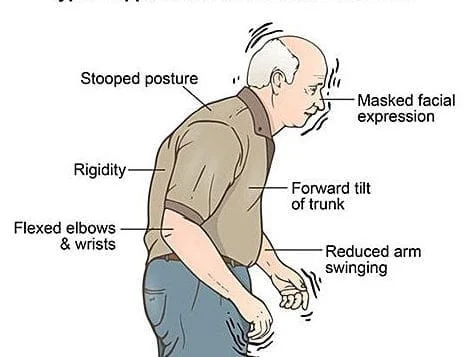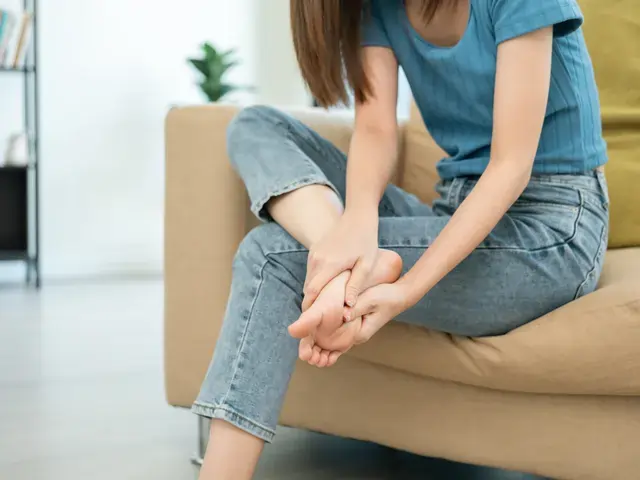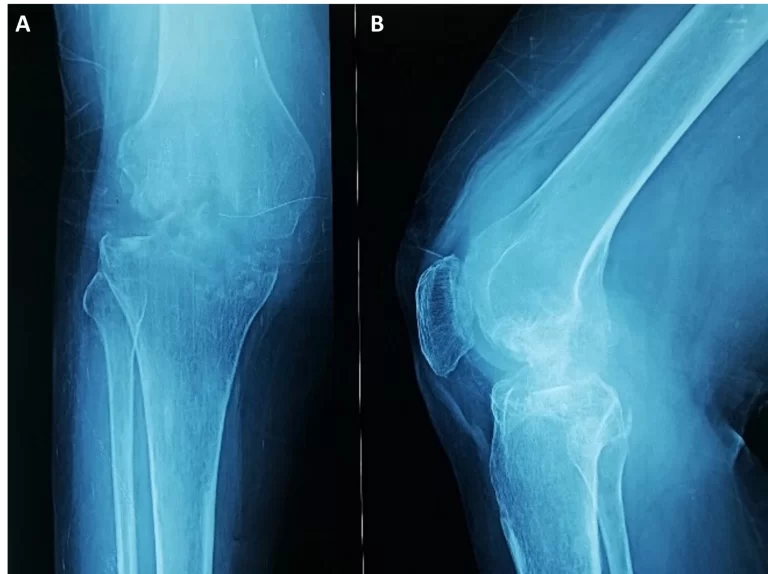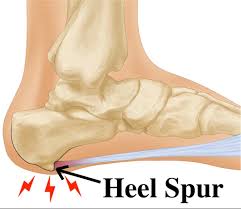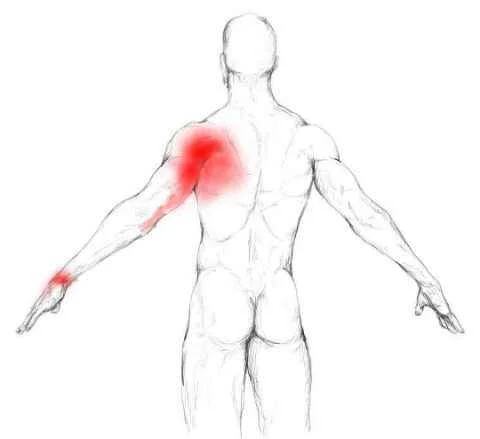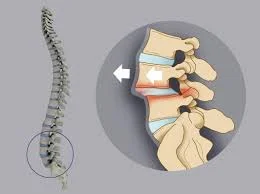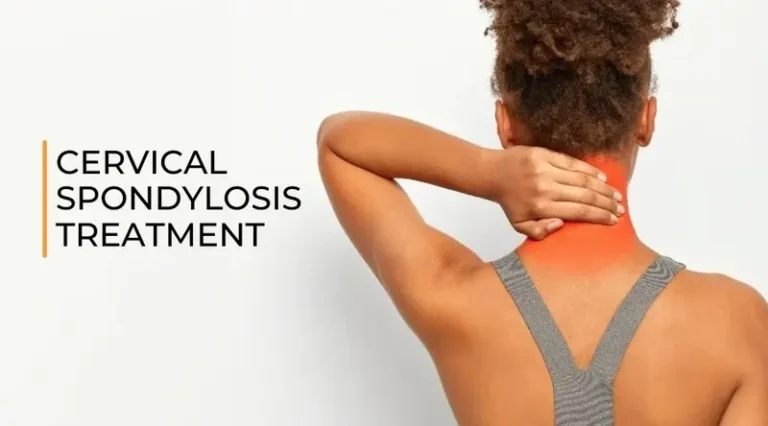Stooped Posture
What is a Stooped Posture?
Stooped posture, also referred to as kyphosis or a hunchback posture, is a condition characterized by an excessive curvature of the spine, typically in the thoracic region. This postural issue is commonly observed in the elderly but can affect individuals of all ages.
Being stooped makes it harder to breathe deeply, which affects your ability to talk clearly and properly. It is also easier to make eye contact while stooping. The muscles in the front of the body become less flexible when one is stooped, while the muscles in the rear get weaker. In addition to being unattractive, a stooped posture may be harmful to one’s health.
People may have back pain or neck pain, for example, if the spine’s natural curvature is out of position. Most smartphone users can probably relate to these symptoms. Additionally, there’s a chance that people will become less flexible, which makes it harder to do daily activities like getting out of bed or dressing. Even worse, though, is that bad posture can impair one’s balance and increase one’s risk of falling.
Children who have poor posture, such as slouching, reclining in seats, and toting large backpacks, may experience straining of the ligaments and muscles supporting their spine. This may cause kyphosis by yanking the thoracic vertebrae out of their natural position. Some experts also advise practicing tai chi or yoga, which stresses maintaining a straight posture. Alternatively, they might try elevating their head and shoulders off the floor for a brief period of time while lying on their stomach.
Stop and take a deep breath if the discussion of health problems linked to poor posture is making you anxious. Yes, you are correct; a hunched-over position limits the amount of oxygen inhaled, making deep breathing challenging. Remember that poor posture can be detrimental. Poor position can lead to imbalances in the muscles and ligaments, which can cause a variety of issues, including:
- Chronic shoulder, neck, and back pain
- Back, hip, knee, and foot injuries
- Headaches
- rigidity
- fatigue
- Weakness and atrophy of muscles
- breathing difficulties
- problems with digestion
- Compression and impingement of nerves
- Sciatica
- Carpal tunnel syndrome.
People may seem slumped over due to these alterations, which might include rounded or stooped shoulders, a smaller low back curvature, or a forward tilt of the head or entire body.
- rigidity or stiffness of muscles
- If individuals are focusing on other tasks (such as walking or using a computer).
It is crucial to make an effort to maintain an erect posture as a stooped posture might have further detrimental effects:
- Back or neck pain may be caused by an abnormality in the spine’s natural curvature.
- Being stooped over makes it harder to breathe deeply, which affects your ability to talk loudly and effectively.
- Additionally, a hunched posture reduces eye contact. When coupled with other signs of Parkinson’s disease such as facial masking and low vocal loudness, this can significantly impair communication.
- It might be difficult to do several tiny motions during the day, such as extending arms aloft to put on clothes or getting out of a chair, if one’s flexibility is compromised by altering posture.
People with poor posture run the risk of falling and losing their balance.
What is Posture?
The capacity to resist gravity and maintain an upright, seated, or lying down position is the definition of posture. Conversely, learning how to move, stand, sit, and lay with your body in a way that minimizes strain on its muscles and ligaments is known as good posture. People who have good posture feel wonderful, are more confident and are more active. It also aids in the management of pain and damage. For those who have bad posture, it can be challenging and perhaps almost impossible to achieve excellent posture. This is due to the fact that improving posture requires not only picking up new techniques and postures but also breaking old habits.
People hold their bodies in certain positions. Two categories exist: When someone is moving, such as when they are walking, jogging, or bending down to pick something up, they are said to be in a dynamic posture. People who are not moving, such as those who are sitting, standing, or sleeping, adopt a static posture.
An ear and the shoulder’s center should line up. The hips, shoulders, and knees must all be in the correct position.
The many problems of spine curvature.
- Lordosis, often known as swayback, is a condition in which a person’s lower back vertebrae flex noticeably inward. Excessive lumbar curvature, or lordosis, provides the illusion of swaybacking the spine.
- The ribs are linked to the thoracic vertebrae, which make up the chest portion.
- Kyphosis
- Scoliosis
Normal Posture:
You must have some understanding of normal posture in order to learn about abnormal posture.
The attitude that the body adopts as it is moving or remains still is known as posture. The coordinated activity of several muscles trying to maintain stability results in posture.
Types of Postures:
There are essentially two categories for postures:
- Inactive Postures: Postures or attitudes chosen during sleeping or relaxing are referred to as inactive postures. Theoretically, they need very little muscular activity, and it is generally considered that they require repose.
- Active posture: To maintain an active posture, a coordinated movement of several muscles is needed. These muscles may be broadly classified into two categories:
- Static postures: These include maintaining and aligning body components in predetermined positions. In order to fight gravity and other forces, different muscle groups must coordinate and interact with one another. This is often accomplished by muscular coordination.
- Dynamic postures: These positions involve movement of the body’s parts. Non-contractile structures and muscles must cooperate to adjust to changing conditions. Walking, running, leaping, throwing, and lifting are a few examples.
Ideal posture:
Postural position assessment needs to adhere to a standard, just like any other examination.
Ideal posture, sometimes referred to as Standard posture, is the optimal skeletal position. We must grasp the optimal position of the spine and other joints when at rest in order to comprehend perfect posture.
This is often accomplished by using a plumb line or by observation; for a position to be considered perfect, the line of gravity must pass through particular body parts. The body should be examined from four angles: the front, back, and sides (left and right).
When observed from all sides, the optimal “normal” erect posture is one in which the line of gravity—a vertical line drawn across the center of gravity of the body.
How To Measure Posture:
- Then passing through the shoulder joint and the bodies of the cervical and lumbar vertebrae, around halfway from the trunk.
- The body should, in theory, be divided into two equal halves by the vertical line that passes through the center of gravity when viewed from either the front.
Posture Assessment
When assessing posture, one should look at symmetry and tilts/rotations from the anterior, lateral, and posterior views. Assess:
- Head positioning
- lumbar, thoracic, and cervical curvatures
- Symmetry at the shoulder level
- Pelvic balance
- Knee, ankle, and hip joints.
Muscle action in posture :
The body’s balanced position lessens the effort required of the muscles to keep it in an upright position. Through the use of electromyography, it has been established that generally:
- The soleus is continually active because gravity has a propensity to pull the body forward over the feet. The deep posterior tibial muscles and the gastrocnemius are less used.
- Unless one is wearing really high heels, the tibialis anterior is dormant.
- The quadriceps and hamstrings are not used much in general.
- Iliopsoas never stops moving.
- Gluteus maximus is not contracting.
- The erector spinae resists gravity’s forward push.
Age-Related Posture Changes
Recently, a buddy inquired about the normalcy of becoming less upright with age. Yes, when individuals get older, they should anticipate becoming more stooped. In addition, people should anticipate losing height and changing their stride. (walking.) Men and women gradually undergo changes starting around the age of thirty. At those ages, all those men and women lose height. After the age of seventy, there is a more noticeable decrease in height.
Why Do We Become Older and Change Our Posture?
Age-related changes in posture are caused by a variety of causes, all of which will be taken into account. Prior to going over each element, it’s crucial to understand that the musculoskeletal system—which includes the bones, muscles, and joints—defines posture. Muscles, joint-like gaps called intervertebral discs, and bones called vertebrae make up the backbone or spinal column. All three are significantly impacted by aging, and as people age, their backs naturally tilt forward, becoming more and more hunched over.
The medical words osteoporosis and osteopenia denote a little to a significant decrease in bone density, respectively. Calcium deficiency leads to a decline in bone density. For women, this starts at menopause, while for men, it starts around age 65. Posture may be affected by a little reduction in the size of the spine’s less dense bones.
One vertebra is separated from the next by a cartilage that has a gelatin-like appearance. The discs grow less flexible and harden as we age because the spine’s whole length becomes compressed. This forward tilt is known as kyphosis. Collectively, these aging changes are referred to as senile kyphosis and are accepted as a typical aspect of aging.
Muscles atrophy and can be replaced by fibrous or adipose tissue, both of which debilitate the muscle. The aging process causes a decrease in muscle mass, which leads to a curvature of the spine.
Statues are also influenced by the transition from a lean to a more obese figure. At age 30, this process starts for both sexes. The two pathologic processes that might result from normal aging and cause the bones and discs to become more painfully bent and stiff are bone fractures and arthritis.
Factors Affecting Postural Changes With Age
- Exercise: Better posture can be achieved with increased frequency of exercise.
- Health comes from a balanced diet that includes fruit, vegetables, and no red meat.
- Restrict your alcohol intake.
- Avoid smoking.
- changes in behavior such as deliberately keeping an upright posture.
Prevention
There are steps people can take to slow down or stop the changes, as there are with most age-related changes. The following list consists of a few things we can control to improve our posture. Readers of these articles are likely familiar with most of the reasons and can explain them on their own. Since exercise improves bone and muscle functioning, which are critical for preserving musculoskeletal health, it is by far the most significant component in maintaining a youthful posture. Pay attention to maintaining an upright posture and avoiding slumping. A person has to be aware of excellent or appropriate posture.
Effects of Bad Posture on the Body
People frequently walk with their heads pulled forward or slanted, gazing down, and sit with their spines bent when trying to read documents or computer screens. These are merely a handful of activities that frequently result in poor posture.
For the body to be supported, for movement, and for nerve communication, the spine is essential. Maintaining bad posture over time can result in a number of health issues beyond only back or neck pain:
- Pain in the back and neck: The muscles, tendons, and ligaments that support these structures are strained and made to move against their natural course.
- Disruption of the nervous system: A misaligned spine interferes with nerve communication, causing pain and numbness in various parts of the body.
- Uncontrollable motions: Uncontrollable shaking and movements in the hands, arms, legs, and other regions might result from the disturbance of the nervous system in addition to strained muscles and other tissues.
- Disruption of organ function: Poor posture causes the lungs and intestines to operate less well, which can cause respiratory and digestive issues.
- Joint issues: Because poor posture causes the body to move and position itself abnormally, it can eventually develop problems with the spine, knee, hip, ankle, and foot joints. In certain joints, arthritis can be exacerbated or develop altogether as a result of the misalignment of the knees and spine.
- Other difficulties – Poor posture can cause a variety of problems, such as persistent tiredness, migraines, incontinence, poor circulation, and degradation of the vertebrae.
- The fact that poor posture is not in and of itself, an illness or medical condition makes it simple to lessen its consequences. In actuality, bad posture causes a host of problems for the body as a whole, including neck and back pain.
Focusing on the Alignment of the Spine
Walking, sitting, driving, and sleeping are examples of everyday actions that should maintain the correct position of the spine.
- stooped over or rounded shoulders
- rounded off
- Pelvic tilt to the posterior (sway back)
- Protruding head beyond the shoulders
- Head tilting back
- bowed knees when standing or walking
- sleeping with the neck and back stooped.
- The pelvis tilts forward, or anteriorly.
- Potbelly
An easy way to screen for poor posture at home is to do a basic spinal position exam and record the findings. While standing, lean your head and your back on a wall. A curvature of the spine is indicated by more than 2 inches.
How to Align The Spine?
Understanding how the hips, back, shoulders, and head are held is necessary for developing and sustaining good posture. It’s crucial to maintain a neutral posture rather than a rigid one, therefore understanding how to straighten the back is crucial.
- Put your chin in.
- To prevent your chest from being thrust out, keep your shoulders back.
- Keep your back straight but not stiff.
- When standing, keep your knees straight (but not locked) or slightly bent. Your butt or chest should not protrude.
Maintaining proper posture is important whether you’re moving or not. The following are some guidelines for maintaining proper posture when performing different tasks and straightening the spine for those who wish to learn how to fix poor posture.
Standing
- Keep your shoulders back but not rigid.
- To reduce stress on the hip, the knee is slightly bent.
- Keep away from or don’t wear high heels or shoes with a sharp angle.
Sitting
- To prevent stress, keep your back in a relaxed position.
- Raise the computer screen to eye level if you’re staring at it.
- Keep your knees just below your hips.
- Plant your feet firmly on the ground.
- Keep your arms away from chair arms to avoid inconsistent your shoulders.
Walking
- Keep your stomach and buttocks in line and avoid protruding either forward or backward.
- Keep your shoulders back and relaxed.
- Looking down will cause a neck bend. Instead, look forward, at least a few steps ahead.
Sleeping
- Maintain the alignment of your neck and spine when choosing a comfortable posture.
- If you sleep on your side, use a cushion between or beneath your knees, where your hips begin, or in the space between your legs to keep your body in position.
- Avoid sleeping with too many pillows as this will cause your neck to flex.
Why posture’s so important?
It aids in the physical development of people’s strength, flexibility, and balance. All of these could result in fewer sore muscles and increased energy levels during the day. Enhancing one’s posture also makes one more conscious of one’s muscles, which facilitates posture correction. People may even become aware of some imbalances or tight spots in their body that they were previously unaware of when they work on their posture and increase their awareness of it.
What are the benefits of a better posture?
In addition to causing muscular stress, poor posture can also cause joint and back pain, as well as decreased circulation. Slouching and slumping are examples of this. Inadequate posture may potentially result in tiredness and respiratory problems.
- improved equilibrium. Not only may improved balance reduce the chance of falls, but it can also enhance athletic performance.
- Less back ache. The discs and vertebrae in the spine experience less pressure and strain when one maintains good posture.
- reduced chance of harm. The stress on the muscles, joints, and ligaments is reduced when one moves, stands, and sits appropriately.
- Less tiredness. More effective muscle usage can contribute to energy conservation.
- Reduced headache frequency. Tension headaches can result from bad posture, which puts additional strain on the neck.
- increased respiration. Proper posture facilitates easy breathing by enabling the lungs to expand to their maximum capacity.
- increased blood flow. It can make it easier for blood to pass through blood vessels and essential organs when your slouching posture does not squeeze such organs.
Being conscious of other people’s posture is the first step towards not slouching. Usually, we are too preoccupied with what other people are doing to notice our own posture. Make it a routine to observe people’s postures all day long. Take note of how people are sitting, standing, and moving. Make adjustments if someone is observed hunching over, slouching, or thrusting their head or neck forward to stare at a screen.
How can a poor posture affect people?
- Having difficulty speaking loudly and clearly
- may cause a shift in balance that causes falls because of the forward shift in weight.
- lessen the postural muscles’ strength
- TMJ pain and headaches
- Having difficulty swallowing
How to help correct the posture?
Stretching:
The anterior half of the body, which includes the chest, shoulders, and neck, has less muscular flexibility due to the forward-flexed posture linked to Parkinson’s disease. Exercises that target the opening of the upper back, neck, and chest can help improve the forward-flexed posture.
Strengthening:
The opposing back muscles get overstretched and are unable to maintain a straight back because the anterior body muscles become less flexible. This ultimately results in fragility. Enhancing the back muscles’ strength will help people stand up straighter for longer.
How to treat a stooped posture?
Half the fight is won when one understands the dangers of weak or poor posture. Increased awareness is necessary to break this unhealthy habit or stop it from occurring in the first place. Here are a few crucial safety measures that are worthwhile in order to preserve a more youthful posture:
- Engage in regular exercise. Yoga and tai chi are examples of mind-body activities that are excellent for enhancing stability and balance.
- As these are known to increase bone density, make sure patients are receiving adequate calcium and vitamin D.
- Cut back on alcohol intake and give up smoking (for more than posture).
- To become more conscious of your body, use the smart posture trainer. With a little vibration, the Upright Go 2 alerts you to correct your posture when it senses slouching.
- Avoid being in one place for an extended period of time; rotate positions whenever possible.
- Invest in a good neck or back support cushion to keep your body in the proper position when you sit.
An exercise in posture correction
Don’t worry if they are already displaying indicators of hunched posture! Stretching exercises that increase flexibility and strengthen the muscles are an easy way to fix this. Keep in mind that having a strong core and back will help you stay erect for longer. Stretches that target enlarging the upper back, neck, and chest include:
- Chin Tucks
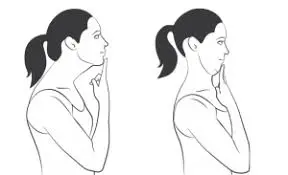
The chin tuck is performed by sitting up straight. People will recognize that someone is performing it correctly if they produce the “double chin” effect. Ten to twenty times a day, repeat.
- Scapular Retractions
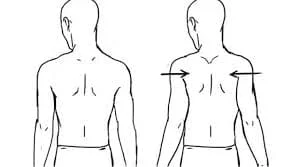
Reducing the rounding of the shoulders is the aim of the scapular retraction. Once more, sit up straight to execute scapular retraction. It should look like people are rowing backward when the elbows are 90 degrees bent and pulled back behind the body. Squeeze the shoulder blades together as the arms retract, being careful to keep the shoulders down and away from the ears. Perform ten to twenty reps each day.
- Thoracic Extensions
to carry out this task. Select a chair with a low back. Place your hands behind your head and extend your elbows as far back as possible. Breathe deeply, then release the air. Do five to ten repetitions a day.
The following techniques and exercises can help people adopt proper posture in place of slouching more often.
- Stand tall
Though it may go unnoticed, a person’s posture can significantly change depending on how they stand. Consider the following advice to ensure proper posture when standing:
Shoulders relaxed and slightly retracted, assuming a tall, erect stance. Imagine the head being slowly pulled toward the ceiling by an unseen piece of string.
Maintain a shoulder-width distance between your feet while primarily supporting your weight on the balls of your feet.
Keep your knees slightly bent.
- Sit correctly
Keep the following in mind when sitting to make sure others are sitting with proper posture:
Maintain a straight posture and relaxed shoulders, without a rounded or stooped back.
Select a chair height that enables users to remain firmly on the ground with their feet. Do not cross your legs.
Reposition yourself such that your spine is supported by the chair’s back.
Observe the position of the head. Keep the chin and head from resting forward on the shoulders.
Keep your ears positioned above your shoulders.
- Move around
Long periods of time spent in one position either sitting or standing can cause weariness, pain, and tense muscles. If they are slouched over, the impacts might be considerably more severe.
Make it a point to get up, stretch, and move about for a few minutes every hour to avoid muscular soreness and exhaustion. To remind individuals to get up and move, set a phone alarm.
Additionally, it could be beneficial for individuals to engage in an activity that requires the use of different muscles than those they employ when sitting or standing.
- Wall slide
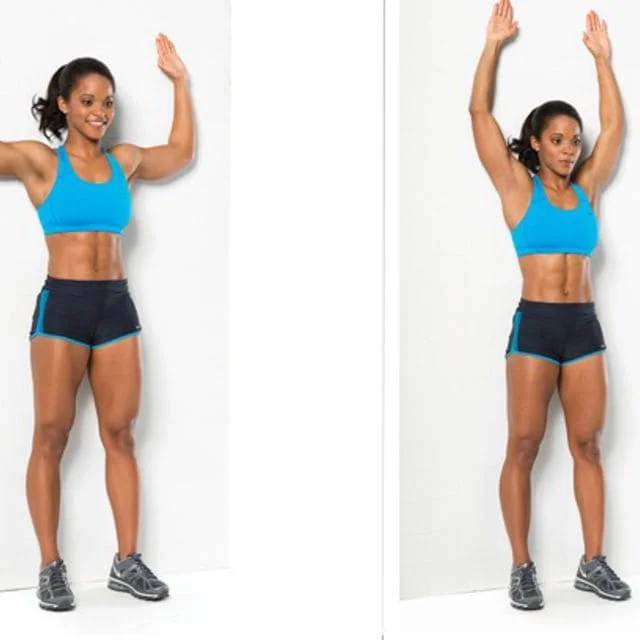
Additionally, it could ease shoulder and neck tension. To slide down a wall: To assist them in aligning their bodies properly, folks might place their feet one or two feet apart from the wall.
Keep your knees slightly bent.
Straighten your arms over people, pressing your palms on the wall. This is where everything begins. It’s okay if at first, you find it difficult to extend your arms. As much as possible, have them raised so that their bodies are crushed up against the wall.
Squeeze the mid-back muscles while lowering the arms toward the shoulders, keeping the back straight and the chest open. Throughout the exercise, keep your head, butt, spine, elbows, shoulders, and backs of your hands firmly up against the wall.
Hold this posture for a brief period before raising the arms back to the beginning position such that nothing is lifted off the wall.
Ten to twelve times, repeat.
- Shoulder blade squeeze
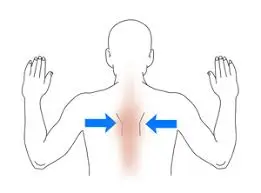
This exercise helps stabilize the muscles in the upper back and shoulders, which can aid with posture. To carry out this task:
Arms at your sides, take a lofty stance.
As if someone were attempting to bring their shoulder blades together, pull the shoulders gently back and downward. Pull until you feel a tiny strain in the muscles, but avoid overextending.
Return to the beginning position after maintaining it for a little while.
Ten times over, repeat.
- Bridge
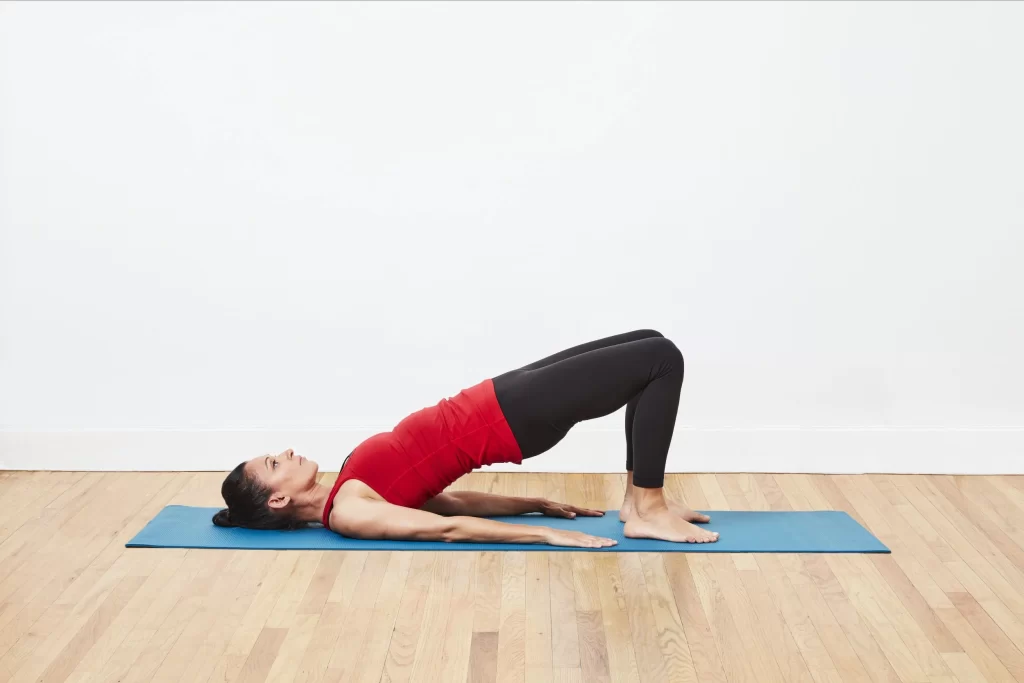
Hold for thirty seconds, then bring the hips down.
Five to eight more times, repeat.
12 Exercises to Improve the Posture
- Child’s pose
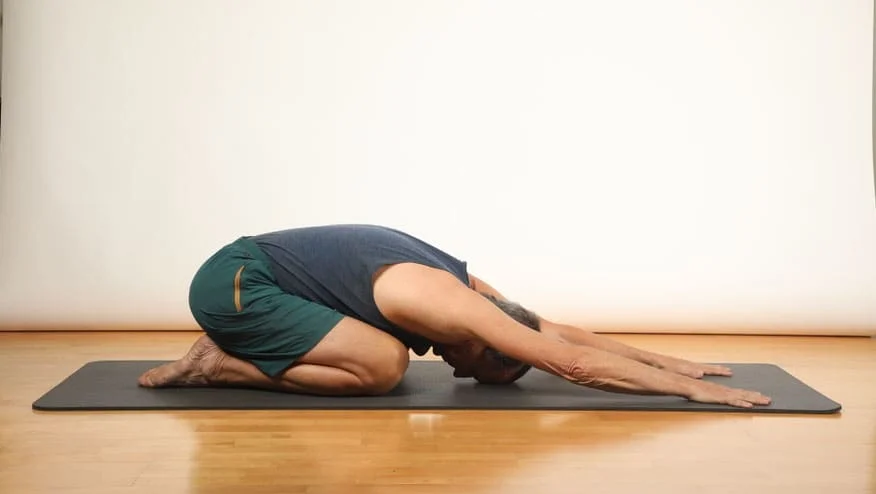
The spine, the glutes, and the hamstrings are all stretched and lengthened in this resting position. Lower back and neck stress can be released by adopting the child’s stance. To carry out this:
With your knees together, your big toes touching, and your heels spread apart, take a seat on your shinbones.
Bend forward at the hips and walk your hands out in front of you.
If someone’s thighs won’t go all the way down, provide support by placing a cushion or folded blanket underneath them.
Keep your arms out in front of you or lay them across your body.
Inhale deeply into the waist and the rear of your rib cage.
Hold this stance for five minutes or more, relaxing and taking deep breaths.
- Forward fold
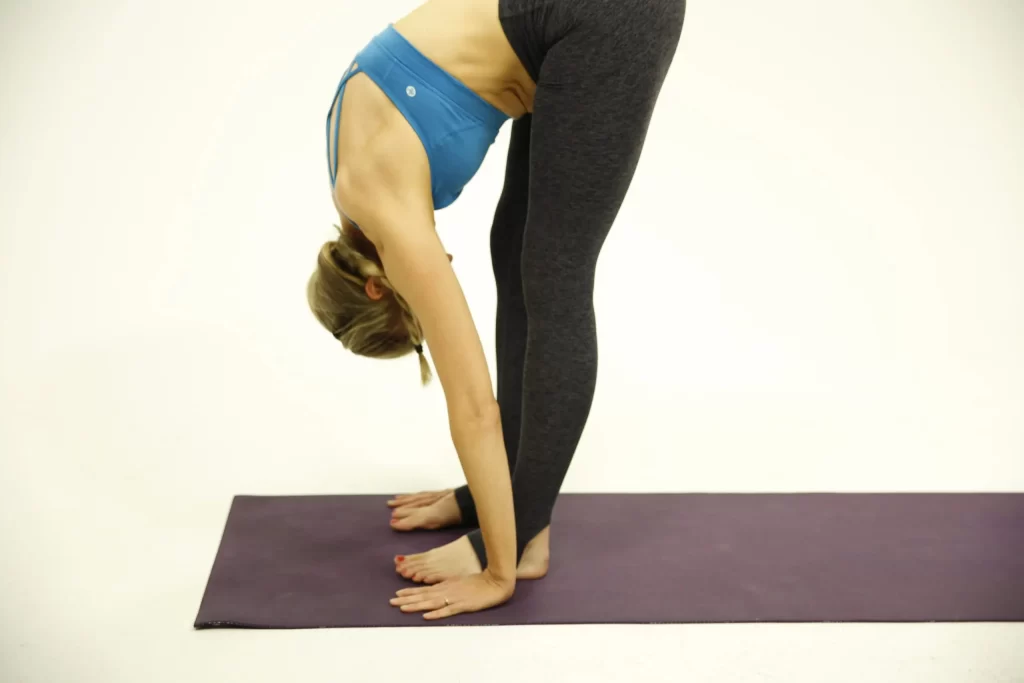
Tension in the glutes, hamstrings, and spine is released with this standing stretch. People should feel their entire backside stretching and opening up as they perform this stretch. To carry out this:
A position when the big toes are in contact and the heels are slightly apart.
Let go and set the hands on a block or the ground. Just go as far as people can; don’t worry if the hands don’t contact the earth.
Let the spine stretch, soften the hip joints, and flex the knees gently.
Allow the head to drop heavily to the floor while tucking the chin toward the chest.
- Cat cow
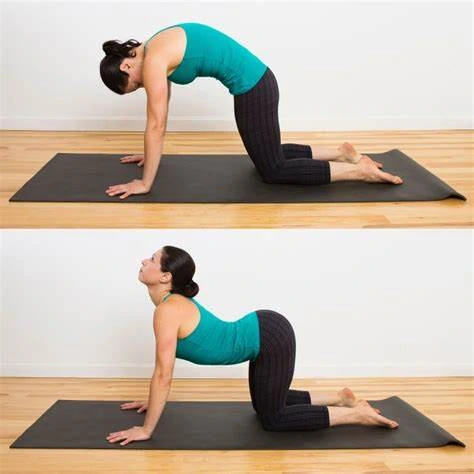
doing spine massages and cat-cow stretches. It also helps to increase blood circulation and reduce stress in the neck, shoulders, and torso. To carry out this:
Place their weight evenly over all four places and go to their hands and knees.
People stretch their spines and inhale to look up, lowering their abdomen toward the earth.
Breathe out, bury your chin into your chest, and arch your spine toward the ceiling.
Maintain this kind of motion for a minimum of sixty seconds.
- Standing cat cow
Stretching your glutes, hips, and back while standing will assist release stiffness in these areas. To carry out this:
Stretch the neck, tuck the chin in close to the chest, and curvature the back.
Next, raise your chest, tilt your head forward, and flex your spine in the other way.
Take five deep breaths at a time while holding each posture.
Keep up this motion for many minutes.
- Chest opener
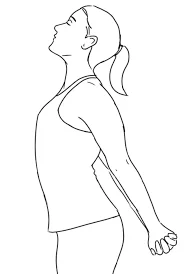
People may expand and stretch their chests with this workout. This is especially helpful for persons who sit for long periods of time, as this causes the chest to inwards shift. Standing up straighter is also facilitated by strengthening the chest. To carry out this:
Fold your arms over your back and cross your fingers, squeezing your palms together. If your hands cannot reach each other, grab the towel.
People should look straight ahead while maintaining a straight head, neck, and spine.
Breathe in as individuals raise their hands to the floor and raise their chests toward the ceiling.
As you hold this stance for five breaths, take deep breaths.
At least ten times, repeat.
- High plank
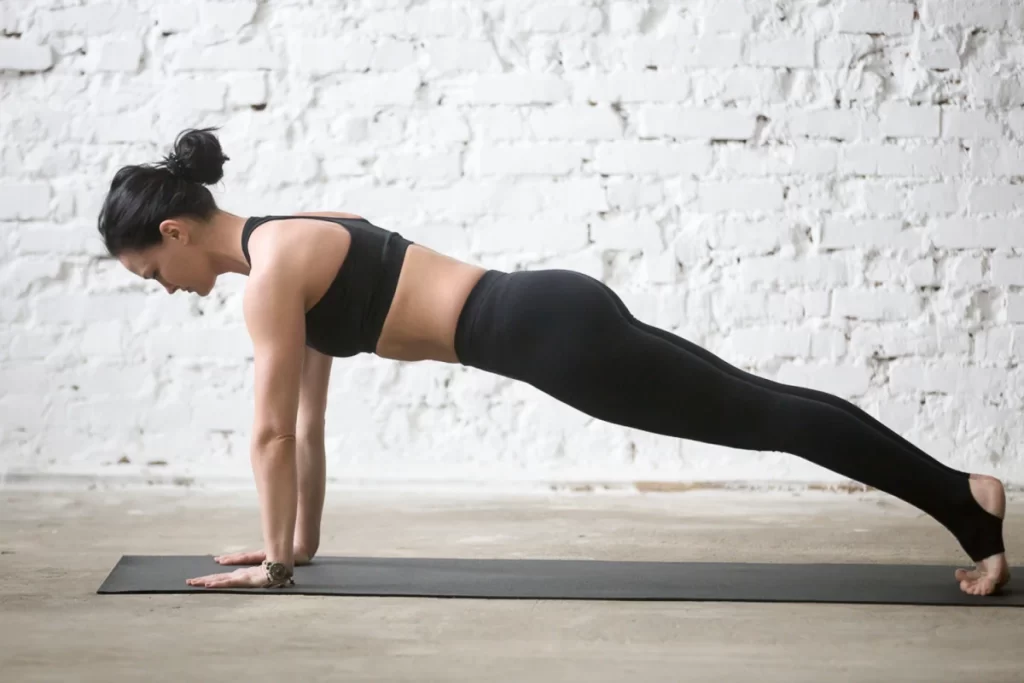
The high plank position strengthens the hamstrings, glutes, and shoulders while reducing stiffness and soreness throughout the body. Additionally, it supports the growth of balance and back and core strength, all of which are critical for proper posture. To carry out this:
While maintaining a straight back, contract your arm, leg, and abdominal muscles.
Lengthen the nape of the neck, relax the throat, and cast your gaze downward.
Hold this posture for a maximum of 60 seconds at a time.
- Side plank
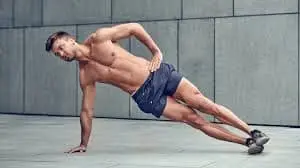
A side plank can be used by people to keep their legs and spine in a neutral stance. Enhancing the strength and position of these muscles contributes to better posture and back support. To carry out this:
For further support, folks might lower their left knee to the floor.
Look up toward the hand, or directly ahead of them.
Hold this position for a maximum of thirty seconds.
On the other side, repeat.
- Downward facing dog
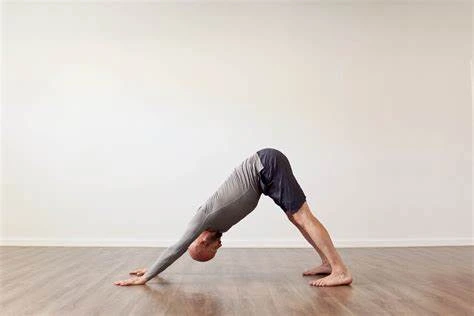
To balance the body, you might employ this forward bend as a resting position. To carry out this:
People should elevate their heels and tuck their toes beneath their feet as they lie on the floor pressing against their hands.
Keep their heels slightly up and apply pressure firmly onto their hands.
- Pigeon pose
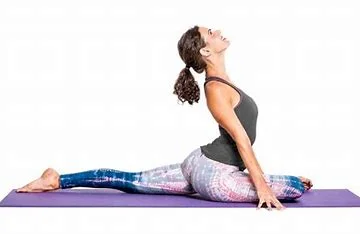
Stretching the quadriceps and sciatic nerve may also be accomplished using the pigeon stance. It is simpler to adjust postural imbalances when certain body parts are opened and stretched. To carry out this:
Place the outside part of your right shin down on the ground.
With the arms out in front of them, slowly lower the body until it rests on the inner right thigh.
On the other side, repeat.
- Thoracic spine rotation
This exercise improves stability and mobility while releasing back pain and tension. To carry out this:
The right hand should remain behind the shoulder or be caused to the middle and rested on the forearm.
In this kind of position, take a single, deep breath and release it.
Return to your starting position by releasing.
Five to ten times, repeat this motion.
On the other side, repeat.
- Glute squeezes
Additionally, it improves the way the hips and pelvis work and align, which improves posture. To carry out this:
Keep your feet about a foot apart from your hips.
Exhale as one approaches the hips with their feet.
Move them farther away from the hips after holding this posture for 10 seconds.
Keep up this motion for a minute.
Do several sets of this kind of workout each day.
- Isometric rows
Long periods of sitting still can cause pain and stiffness, which this exercise helps to relieve. By strengthening the muscles in the arms, shoulders, and back, isometric pulls help people maintain proper posture. To carry out this:
They are seated in chairs with plush backs.
People who strain their shoulder blades together and pull their elbows back into the chair behind them should exhale.
Take deep breaths while holding this posture for ten seconds.
Do this motion again for a minute.
Managing Posture Changes
Try these techniques to maintain proper posture:
- Keep an eye out for changes in posture. Make an effort to recognize when you are bending or leaning, then adjust yourself accordingly.
- Shift around a lot. Take pauses to move!
- To improve your sitting posture, get neck (or cervical) or back (or lumbar) rolls or cushions.
- Take up Tai Chi or yoga lessons.
- Make a call or consult the physician.
- The muscles in the front of the body become less flexible when one is stooped, while the muscles in the rear get weaker.
Conclusion
Like so many other aspects of healthy aging, there are unchangeable, ongoing changes that occur just as a natural byproduct of growing older. One of the things we lose as we age is erect posture, but there are several ways to slow down or prevent these changes in posture as our bones, muscles, and joints deteriorate. Being aware of your posture at all times is essential to avoiding slouching and hunching.
To avoid tight or stiff muscles from sitting still for extended periods of time, set phone notifications to remind you to sit up straight and take frequent rests. In addition to mobility and posture checks, it helps to perform stretches and exercises on a regular basis to maintain strong, flexible muscles that are better equipped to support people in maintaining excellent posture.
FAQs
How does one differentiate between stooping and bending?
Bending over a few objects below waist level or down towards an object on or near the ground is known as stooping. It involves bending the body forward and down and bending the spine at the waist 45 degrees or more.
How does one assume a stooping position?
People may seem slumped over due to these alterations, which might include rounded or stooped shoulders, a diminished low back curvature, or a forward tilt of the head or entire body.
Can one repair a stoop?
Do not worry if others are already displaying indicators of hunched posture! Stretching activities that improve flexibility and strengthen muscles are an easy way to address this. Recall that people can stand for longer periods of time if they have a strong back and core.
What causes humans to stoop?
Muscles, joint-like gaps called intervertebral discs, and bones called vertebrae make up the backbone or spinal column. All three are significantly impacted by aging, and as people age, their backs naturally tilt forward, becoming more and more hunched over.
How can I get over my stoop?
The muscles in the upper back, chest, and core need to be strengthened and stretched in order to correct bad posture. Scapula squeezes, which include pressing your shoulder blades together for 30 seconds at a time, and rows, which involve pulling back your elbows with a resistance band like you’re rowing, are two exercises that strengthen your shoulders.
Is stooped over normal?
Hyperkyphosis is a forward-leaning, hunched-over posture that becomes increasingly frequent as one ages. Headaches, neck and back pain, as well as digestive and respiratory issues, are some of the symptoms associated with hyperkyphosis.
How can one become upright again?
Continue to flex your knees gently. Put your hands in your belly. If you must stay still for an extended period of time, shift your weight from your toes to your heels or from one foot to the other.
Which illnesses result in a hunched posture?
Because Parkinson’s disease (PD) impairs the regulation of autonomic actions, alterations in posture may transpire in the absence of the brain’s natural prompts to stand up straight. You may seem bent over due to these changes, which might include rounded or stooped shoulders, a diminished low back curvature, or a forward tilt of the head or entire body.
What is meant by a stooped posture?
To slouch over a desk by bending the head, shoulders, or body in general forward and downward from an upright position.
What is the posture of stooping?
Stooping is a posture in which the torso is bent forward and downward and the spine is bent at least 45 degrees at the waist, either over something below the waist or down toward something on or near the ground. When bending, workers should be stooping to the point where their hands would be at or below their knees if their arms were extended.
How can a stooped posture be corrected?
The muscles in the upper back, chest, and core need to be strengthened and stretched in order to correct bad posture. Scapula squeezes, which include pressing your shoulder blades together for 30 seconds at a time, and rows, which involve pulling back your elbows with a resistance band like you’re rowing, are two exercises that strengthen your shoulders.
What posture stooping is caused by?
All three are significantly impacted by aging, and as people age, their backs tend to curve forward, which causes them to assume progressively hunched postures. The medical words osteoporosis and osteopenia denote varying degrees of bone density loss. The decrease of density in the bones is caused by the loss of calcium.
What do you name a stooping position?
Hyperkyphosis is a forward-leaning, hunched-over posture that becomes increasingly frequent as one ages. Hyperkyphosis can result in respiratory and digestion problems, as well as headaches, neck and back pain, and other symptoms.
Is stooped posture correctable?
Do not worry if others are already displaying indicators of hunched posture! Stretching activities that improve flexibility and strengthen muscles are an easy way to address this. Recall that people can stand for longer periods of time if they have a strong back and core.
What puts one in a stooped position?
Children who have poor posture, such as slouching, reclining in seats, and toting large backpacks, may experience straining of the ligaments and muscles supporting their spine. This may cause kyphosis by yanking the thoracic vertebrae out of their natural position.
What is a stooped position?
The muscles in the front of the body become less flexible when one is stooped, while the muscles in the rear get weaker.
References
- Stooped posture – Treatment, Exercise – Mobile Physio. (2023, December 13). Mobile Physiotherapy Clinic. https://mobilephysiotherapyclinic.in/stooped-posture/

